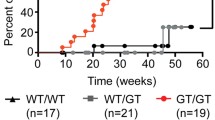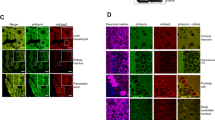Abstract
Apoptosis as well as autophagy have been implicated in the death of cerebellar Purkinje cells (PCs) in the Lurcher (Lc/+) mutant mouse and at least two different apoptotic pathways participate in the transsynaptic death of granule cells (GC) and inferior olivary (IO) neurones. The relative contribution of these pathways can only be assessed from their momentary involvement at any stage of the complete course of neurodegeneration. Here we used quantitative labelling for activated caspase-3 (Casp-3) and Fluoro-Jade B (FJ-B) to investigate the spatio-temporal pattern of neuronal death from P6 to P67 in Lc/+ mutants. Activated Casp-3 was present only in narrow time intervals (P14 to P22 in PCs; P14 to P28 in GCs) and in small subpopulations of PCs, GCs, and IO neurones. FJ-B positive PCs were detected during a broader period (P14 to P28), and outnumbered Casp-3 labelled PCs by a factor exceeding eight. Nevertheless, FJ-B labelling was restricted to PCs and never found in either GC or IO neurones. In conclusion, we present the first complete time course and extent of Casp-3 activation in Lc/+ mutants and show that the majority of dying neurones in Lc/+ mutants undergo Casp-3 independent cell death. The cellular overload produced by the initial gene defect in Lc/+ mutants apparently activates a variety of apoptotic and non-apoptotic pathways within the same neuronal population. Moreover, we present the first evidence for the ability of FJ-B to selectively label a discrete population of dying PCs, implying a higher selectivity of FJ-B than previously supposed.





Similar content being viewed by others
Abbreviations
- BSA:
-
Bovine serum albumin
- Calb:
-
CalbindinD-28k
- Casp-3:
-
Caspase-3
- FITC:
-
Fluorescein isothiocyanate
- FJ:
-
Fluoro-Jade
- GC:
-
Granule cell
- GluRδ2:
-
Glutamate receptor delta 2
- GRID2:
-
Glutamate receptor ionotrophic delta 2 gene
- IO:
-
Inferior olive
- Lc/+:
-
Lurcher mutant
- P:
-
Postnatal day
- PAP:
-
Peroxidase-antiperoxidase
- PBS:
-
Phosphate-buffered saline
- PC:
-
Purkinje cell
- PCR:
-
Polymerase chain reaction
- TBS:
-
Tris-buffered saline
References
Anderson KJ, Fugaccia I, Scheff SW (2003) Fluoro-jade B stains quiescent and reactive astrocytes in the rodent spinal cord. J Neurotrauma 20:1223–1231
Baehrecke EH (2005) Autophagy: dual roles in life and death? Nat Rev Mol Cell Biol 6:505–510
Batini C (1990) Cerebellar localization and colocalization of GABA and calcium binding protein-D28K. Arch Ital Biol 128:127–149
Bäurle J, Vogten H, Grüsser-Cornehls U (1998) Course and targets of the calbindin D-28k subpopulation of primary vestibular afferents. J Comp Neurol 402:111–128
Blum D, Hemming FJ, Galas MC,Torch S, Cuvelier L, Schiffmann SN, Sadoul R. (2004) Increased Alix (apoptosis-linked gene-2 interacting protein X) immunoreactivity in the degenerating striatum of rats chronically treated by 3-nitropropionic acid. Neurosci Lett 368:309–313
Caddy KW, Biscoe TJ (1979) Structural and quantitative studies on the normal C3H and Lurcher mutant mouse. Philos Trans R Soc Lond B Biol Sci 287:167–201
Celio MR, Baier W, Schärer L, Gregersen HJ, de Viragh PA, Norman AW (1990) Monoclonal antibodies directed against the calcium binding protein Calbindin D-28k. Cell Calcium 11:599–602
Choi DW (1995) Calcium: still center-stage in hypoxic-ischemic neuronal cell death. Trends Neurosci 18:58–60
Chu T, Hullinger H, Schilling K, Oberdick J (2000) Spatial and temporal changes in natural and target deprivation-induced cell death in the mouse inferior olive. J Neurobiol 43:18–30
Citron BA, Arnold PM, Sebastian C, Qin F, Malladi S, Ameenuddin S, Landis ME, Festoff BW (2000) Rapid upregulation of caspase-3 in rat spinal cord after injury: mRNA, protein, and cellular localization correlates with apoptotic cell death. Exp Neurol 166:213–226
Doughty ML, De Jager PL, Korsmeyer SJ, Heintz N (2000) Neurodegeneration in Lurcher mice occurs via multiple cell death pathways. J Neurosci 20:3687–3694
Dumesnil-Bousez N, Sotelo C (1992) Early development of the Lurcher cerebellum: Purkinje cell alterations and impairment of synaptogenesis. J Neurocytol 21:506–529
Eisch AJ, Schmued LC, Marshall JF (1998) Characterizing cortical neuron injury with Fluoro-Jade labeling after a neurotoxic regimen of methamphetamine. Synapse 30:329–333
Eyüpoglu IY, Savaskan NE, Brauer AU, Nitsch R, Heimrich B (2003) Identification of neuronal cell death in a model of degeneration in the hippocampus. Brain Res Protoc 11:1–8
Frank TC, Nunley MC, Sons HD, Ramon R, Abbott LC (2003) Fluoro-jade identification of cerebellar granule cell and Purkinje cell death in the alpha1A calcium ion channel mutant mouse, leaner. Neuroscience 118:667–680
Freyaldenhoven TE, Ali SF, Schmued LC (1997) Systemic administration of MPTP induces thalamic neuronal degeneration in mice. Brain Res 759:9–17
Garcia-Segura LM, Baetens D, Roth J, Norman AW, Orci L (1984) Immunohistochemical mapping of calcium-binding protein immunoreactivity in the rat central nervous system. Brain Res 296:75–86
Garin N, Hornung JP, Escher G (2002) Distribution of postsynaptic GABA(A) receptor aggregates in the deep cerebellar nuclei of normal and mutant mice. J Comp Neurol 447:210–217
Harkany T, Grosche J, Mulder J, Horvath KM, Keijser J, Hortobagyi T, Luiten PG, Hartig W (2001) Short-term consequences of N-methyl-D-aspartate excitotoxicity in rat magnocellular nucleus basalis: effects on in vivo labelling of cholinergic neurons. Neuroscience 108:611–627
Heckroth JA, Eisenman LM (1991) Olivary morphology and olivocerebellar topography in adult Lurcher mutant mice. J Comp Neurol 312:641–651
Hollman M, Heinemann S (1994) Cloned Glutamate Receptors. Annu Rev Neurosci 17:31–103
Hopkins KJ, Wang G, Schmued LC (2000) Temporal progression of kainic acid induced neuronal and myelin degeneration in the rat forebrain. Brain Res 864:69–80
Hu B, Zheng F (2005) Differential effects on current kinetics by point mutations in the lurcher motif of NR1/NR2A receptors. J Pharmacol Exp Ther 312:899–904
Kerr JF, Wyllie AH, Currie AR (1972) Apoptosis: a basic biological phenomenon with wide-ranging implications in tissue kinetics. Br J Cancer 26:239–257
Kim HT, Waters K, Stoica G, Qiang W, Liu N, Scofield VL, Wong PK (2004) Activation of endoplasmic reticulum stress signaling pathway is associated with neuronal degeneration in MoMuLV-ts1-induced spongiform encephalomyelopathy. Lab Invest 84:816–827
Kokaia Z, Andsberg G, Yan Q, Lindvall O (1998) Rapid alterations of BDNF protein levels in the rat brain after focal ischemia: evidence for increased synthesis and anterograde axonal transport. Exp Neurol 154:289–301
Kretsinger RH (1980) Crystallographic studies of calmodulin and homologs. Ann NY Acad Sci 356:14–19
Krinke GJ, Classen W, Vidotto N, Suter E, Würmlin Ch (2001) Detecting necrotic neurons with fluoro-jade stain. Exp Toxic Pathol 53:365–372
Kuida K, Zheng TS, Na S, Kuan C, Yang D, Karasuyama H, Rakic P, Flavell RA (1996) Decreased apoptosis in the brain and premature lethality in CPP32-deficient mice. Nature 384:368–372
Larsson E, Lindvall O, Kokaia Z (2001) Stereological assessment of vulnerability of immunocytochemically identified striatal and hippocampal neurons after global cerebral ischemia in rats. Brain Res 913:117–132
Legrand C, Thomasset M, Parkes CO, Clavel MC, Rabie A (1983) Calcium-binding protein in the developing rat cerebellum. An immunocytochemical study. Cell Tissue Res 233:389–402
Liang XH, Kleeman LK, Jiang HH, Gordon G, Goldman JE, Berry G, Herman B, Levine B (1998) Protection against fatal Sindbis virus encephalitis by beclin, a novel Bcl-2-interacting protein. J Virol 72:8586–8596
Liu HN, Giasson BI, Mushynski WE, Almazan G (2002) AMPA receptor-mediated toxicity in oligodendrocyte progenitors involves free radical generation and activation of JNK, calpain and caspase 3. J Neurochem 82:398–409
LoPachin RM, Balaban CD, Ross JF (2003) Acrylamide axonopathy revisited. Toxicol Appl Pharmacol 188:135–153
Lossi L, Cantile C, Tamagno I, Merighi A (2005) Apoptosis in the mammalian CNS: Lessons from animal models. Vet J 170:52–66
Lossi L, Merighi A (2003) In vivo cellular and molecular mechanisms of neuronal apoptosis in the mammalian CNS. Prog Neurobiol 69:287–312
Lu W, Tsirka SE (2002) Partial rescue of neural apoptosis in the Lurcher mutant mouse through elimination of tissue plasminogen activator. Development 129:2043–2050
Pennypacker KR, Eidizadeh S, Kassed CA, O’Callaghan JP, Sanberg PR, Willing AE (2000) Expression of fos-related antigen-2 in rat hippocampus after middle cerebral arterial occlusion. Neurosci Lett 289:1–4
Phillips RJS (1960) “Lurcher,” a new gene in linkage group XI of the house mouse. J Genet 57:35–42
Scheff SW, Rabchevsky AG, Fugaccia I, Main JA, Lump JE Jr (2003) Experimental modeling of spinal cord injury: characterization of a force-defined injury device. J Neurotrauma 20:179–193
Schmued LC, Albertson C, Slikker W Jr (1997) Fluoro-Jade: a novel fluorochrome for the sensitive and reliable histochemical localization of neuronal degeneration. Brain Res 751:37–46
Schmued LC, Hopkins KJ (2000) Fluoro-Jade B: a high affinity fluorescent marker for the localization of neuronal degeneration. Brain Res 874:123–130
Schmued LC, Stowers CC, Scallet AC, Xu L (2005) Fluoro-Jade C results in ultra high resolution and contrast labeling of degenerating neurons. Brain Res 1035:24–31
Selimi F, Doughty M, Delhaye-Bouchaud N, Mariani J (2000a) Target-related and intrinsic neuronal death in Lurcher mutant mice are both mediated by caspase-3 activation. J Neurosci 20:992–1000
Selimi F, Vogel MW, Mariani J (2000b) Bax inactivation in Lurcher mutants rescues cerebellar granule cells but not Purkinje cells or inferior olivary neurons. J Neurosci 20:5339–5345
Shintani T, Klionsky DJ (2004) Autophagy in health and disease: a double-edged sword. Science 306:990–995
Sternberger LA, Hardy PH Jr, Cuculis JJ, Meyer HG (1970) The unlabeled antibody enzyme method of immunohistochemistry: preparation and properties of soluble antigen-antibody complex (horseradish peroxidase-antihorseradish peroxidase) and its use in identification of spirochetes. J Histochem Cytochem 18:315–333
Swisher DA, Wilson DB (1977) Cerebellar histogenesis in the Lurcher (Lc) mutant mouse. J Comp Neurol 173:205–218
Thornberry NA, Rosen A, Nicholson DW (1997) Control of apoptosis by proteases. Adv Pharmacol 41:155–177
Toninello A, Salvi M, Mondovi B (2004) Interaction of biologically active amines with mitochondria and their role in the mitochondrial-mediated pathway of apoptosis. Curr Med Chem 11:2349–2374
Vogel MW (2002) Cell death, Bcl-2, Bax, and the cerebellum. Cerebellum 1:277–287
Wetts R, Herrup K (1982a) Interaction of granule, Purkinje and inferior olivary neurons in Lurcher chimaeric mice. I. Qualitative studies. J Embryol Exp Morphol 68:87–98
Wetts R, Herrup K (1982b) Interaction of granule, Purkinje and inferior olivary neurons in Lurcher chimeric mice. II. Granule cell death. Brain Res 250:358–362
Wood KA, Dipasquale B, Youle RJ (1993) In situ labeling of granule cells for apoptosis-associated DNA fragmentation reveals different mechanisms of cell loss in developing cerebellum. Neuron 11:621–632
Yue Z, Horton A, Bravin M, DeJager PL, Selimi F, Heintz N (2002) A novel protein complex linking the delta 2 glutamate receptor and autophagy: implications for neurodegeneration in Lurcher mice. Neuron 35:921–933
Zanjani HS, Rondi-Reig L, Vogel MW, Martinou JC, Delhaye-Bouchaud N, Mariani J (1998) Overexpression of a Hu-Bcl-2 gene in Lurcher mutant mice delays Purkinje cell death. C R Acad Sci III 321:633–640
Zanjani HS, Vogel MW, Martinou JC, Delhaye-Bouchaud N, Mariani J (1998) Postnatal expression of Hu-bcl-2 gene in Lurcher mutant mice fails to rescue Purkinje cells but protects inferior olivary neurons from target-related cell death. J Neurosci 18:319–327
Zuo J, De Jager PL, Takahashi KA, Jiang W, Linden DJ, Heintz N (1997) Neurodegeneration in Lurcher mice caused by mutation in delta2 glutamate receptor gene. Nature 388:769–773
Zweifel LS, Kuruvilla R, Ginty DD (2005) Functions and mechanisms of retrograde neurotrophin signalling. Nat Rev Neurosci 6:615–625
Acknowledgments
We wish to thank Ms H. Wolynski for technical assistance and Dr L.C. Schmued for stimulating discussions. This study was supported in part by the Sonnenfeld-Stiftung.
Author information
Authors and Affiliations
Corresponding author
Rights and permissions
About this article
Cite this article
Bäurle, J., Kranda, K. & Frischmuth, S. On the variety of cell death pathways in the Lurcher mutant mouse. Acta Neuropathol 112, 691–702 (2006). https://doi.org/10.1007/s00401-006-0137-x
Received:
Revised:
Accepted:
Published:
Issue Date:
DOI: https://doi.org/10.1007/s00401-006-0137-x




